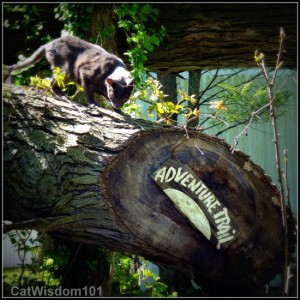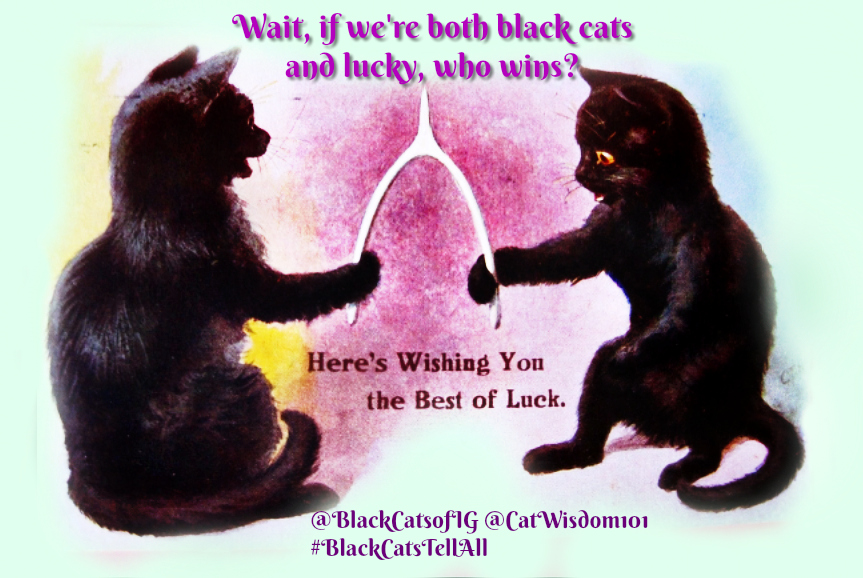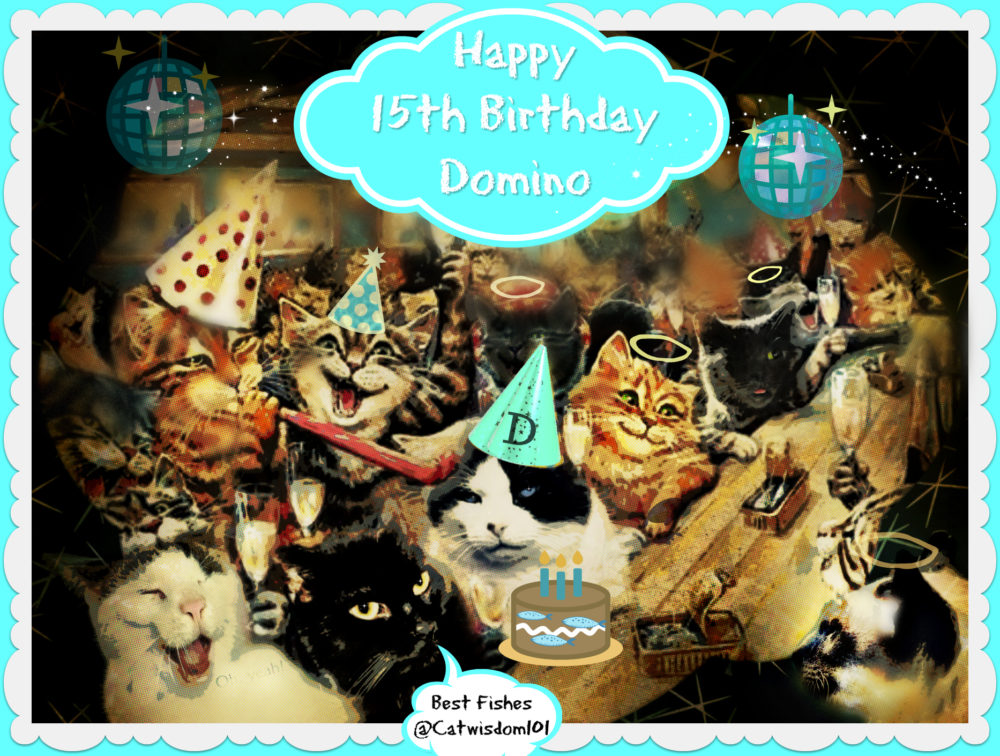Vet 101:Cats Just Wanna Have Fun
Cats just wanna have fun and adventure but at what cost? Not all cats are as intrepid but cleverly cautious as Gris Gris. He’s never taken a misstep on his outdoor jungle-gym. But cats are curious and known to tread where they shouldn’t. This brings us to this week’s Vet 101 reader question from our cat expert and vet Dr. Richard Goldstein. To learn more about him, click on the Vet 101 tab above. He also addresses Vaccine-associated fibrosarcomas or VAS this week. Have a question? Send it to [email protected]
Q: During the recent hurricane, our cat ran into the basement (unfinished) to play in the puddles and returned with very dirty paws. We used a mild soap and sprayed water to rinse but they’re still quite dirty. Any suggestions for cleaning and could there be any danger from him licking anything toxic?
A: Well, I guess your kitty has debunked the theory that cats hate water! You did the right thing by using a mild soap and water. Who knows what can be in puddle water! There can be oils and toxins that run off from the streets (motor oil and antifreeze can be deadly!), parasites and bacteria that can live in the water, and sometimes even sewage (that happens a LOT when there are big storms and the sewers and storm drains overflow). Since cats are such avid groomers, anything they get on their feet has the potential to cause problems not only from absorption through the skin, but also through ingestion. So, it’s very important for us to clean their feet for them to avoid these potential hazards. It’s also important to keep this in mind when selecting a product to clean the feet with.
Depending on what was stepped in, a non-detergent based dishwashing soap like Joy will often help with cleaning. Shampoos that are safe for cats can be very effective for cleaning the feet. If your kitty likes the water, letting the feet soak in a little water with Joy for a few minutes may allow the debris to be more easily rinsed off (you know, like Madge in the old Palmolive commercials?). Pet wipes or hypoallergenic baby wipes can help too. In cases of an oily or sticky substance, this can be tricky. Peanut butter often works, and can fairly easily be washed off with warm water. The important things to remember are: don’t use anything caustic or abrasive (no nail polish remover or turpentine!), and make sure you thoroughly rinse it off and dry the feet.
Editor’s Note: Since most cats don’t like water, make sure the water temperature is comfortably warm but not too hot. I find paper towels more absorbent and malleable for drying in between toes than a thick towel.
Vaccine-associated fibrosarcomas (VAS)
Vaccine-associated fibrosarcomas are very rare in cats, but the subject nevertheless warrants attention. Over the past 15 years or so, research has suggested that the formation of the tumors was often caused by a combination of the adjuvant in the rabies and leukemia vaccines – the other “stuff” in the vaccines that makes the body mount an immune response to the disease being vaccinated against – and the genetics of the individual cat. In many cases the adjuvant was aluminum-based. In some multi-dose vials of vaccine, it was suggested that the amount of adjuvant may have been higher in the doses from the end of the bottle than the beginning, especially if the vial wasn’t shaken thoroughly before drawing up a dose. To combat these findings, many drug companies have changed their method of vaccine manufacturing.
Today, many vaccines are non-adjuvanted (like Merial’s Purevax Rabies) and come in single-dose vials (most companies have adopted this policy). Merial also came out with an “intradermal spray” leukemia vaccine, and Heska came out with an intranasal FVRCP vaccine, that avoid injections under the skin. All of these changes have resulted in a significant reduction in the number of vaxosarcomas seen in recent years. In addition, changes in vaccine protocols and strategies have reduced the incidence of tumors. Every cat does NOT need every vaccine every year. As we’ve discussed before, it is essential to have a frank discussion with your veterinarian about your cat’s lifestyle and risks, and decide which vaccines are needed, and how often. By adhering to the AAFP vaccine guidelines, avoiding unnecessary vaccination, and addressing any lumps and bumps that develop as soon as possible, we can significantly minimize the risk of vaxosarcoma development. The benefits of vaccination against the core diseases far outweigh the risks of developing a vaxosarcoma.






15 Comments
Sweet Purrfections
P.S. The vet did use the Merial’s Purevax vaccination on all of the kittens.
Sweet Purrfections
Hi!
Thank you for posting this today and visiting my blog. I’m the person who recently lost a kitten (1 1/2 weeks before he was to come live with me) to VAS. Beignet had his first vaccination at 9 weeks and a week later the lump was discovered. The vet(s) didn’t think it was anything to be concerned about, but my breeder (who is a vet tech) insisted the tissue sample be sent off for a pathology report. It came back as VAS and additional surgery was required to remove the effected tissue. Unfortunately, Beignet was only 11 weeks old and couldn’t survive the amount of time he was required to be under anesthesia. The breeder is working with several vet oncologists and pathologists to research his tissue samples because his case was so rare and surprised everyone. I will have a LONG talk with the new vet when Truffle (Beignet’s sister) comes to live with me this week.
Mom Paula
MoMo
Thanks for visiting me. This is a great site with lots of interesting info.
My party is on NOW. Please come back and play any time over the weekend and be part of the charity drive for The Cat Protection Society. My folks are giving a small donation for every visitor who comes to the party this long weekend.
Tamago
It’s so scary that we get vaccination for our kitties because we think it’s a good thing but it could cause disease. I’m glad it is safer now.
Thank you so much for stopping by my blog. It is very nice to meet you 🙂
Bernadette
I’m really surprised that the cause of VAS was discovered so quickly, relatively speaking. Many people dismissed it as coincidental just a few years ago. For all the animals who have given their lives in tests and trials for our medications and treatments, I’m glad more didn’t have to die in using their own.
Much as I dislike P&G for other things, and they did use the popularity of Dawn to their advantage in the Gulf cleanup, but it was actually scientists and volunteers cleaning up after the Exxon Valdez oil spill in Prince William Sound in 1989, using all sorts of detergents and cleaners, who named Dawn the best and safest for cleaning crude oil from shorebirds’ feathers. Don’t know if a study was ever done, but since then Dawn has been suggested for cleaning pollutants out of fur and feathers in nearly every environmental cleanup I’ve heard about, even locally when diesel spilled on the rivers in Pittsburgh and when we had massive local flooding.
Thanks for publishing your vet’s remarks!
boomermuse
Bernadette, there has been no study to compare Dawn to other similar products. The remarks referencing Dawn are my own.
Kent Butler
As to the detergent, I’m surprised you said Joy instead of Dawn, as Dawn is widely used to clean bird and animals at oil spills. Works great in the kitchen, too. Any thoughts?
boomermuse
Both products are similar petroleum-based products and owned by Procter & Gamble who sent 7,000 bottles of Dawn to the Gulf of Mexico to help clean up birds covered in BP’s oil. Dawn cleverly capitalized on this PR goldmine and runs commercials and social media campaigns highlighting the cleanup.
Fluffy and Heather
I’ve never heard of a cat who loves to jump in puddles! I guess there’s a first for everything! Thank you so much for stopping by my blog, by the way. Whereabouts in Canada are you from? I was born and lived near Toronto for most of my life, but then, when my parents moved back to the UK, I decided to try out living abroad. Of course, Italy was the most logical choice, as it would be for any pizza and art lover! 🙂 See you again soon!
boomermuse
Hi Heather, I’m originally from Montreal but lived in Toronto until about ten years ago. Where in Italy are you? A friend’s daughter just left to do a semester abroad in Rome.
Marg
Good to know those facts about the VAS. I wonder if it is just the first shot that causes the cancer?? It probably is since it has a little to do with the genetics of the cat. But glad to hear that they are changing the vaccines so that they are safer. Now if the vets will just pay attention. Great post.
Brian
VAS is what happened to sweet little Beignet, so very sad.
boomermuse
Brian, so that’s why you wanted to info. Poor sweet girl.
Milo and Alfie
Thank you for the information about vacine risks. We learned something.
Recently a dear friend’s beloved kitten died of cancer (he developed cancer – vaccination associated fibrosarcomas (VAS) from his booster shoot, and he died on the operating table during the second surgery) and we were deeply shocked. we had no idea there was such a risk before. his blog is here: http://sweetpurrfections.blogspot.com/p/beignet.html
Kathryn
Fascinating to know all this!~!